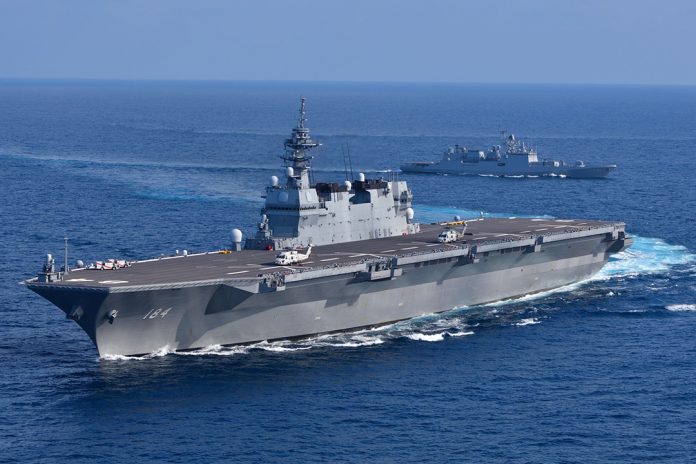The Japan Maritime Self-Defense (JMSDF) has likely gained valuable insights on ship-based short take-off and vertical landing (STOVL) operations with the inaugural port call of the Italian Navy’s aircraft carrier ITS Cavour in Japan in late August.
The 244-metre-long Cavour, which was carrying eight STOVL-capable Lockheed Martin F-35B Joint Strike Fighters and seven AV-8B Harrier II Plus aircraft, docked at the JMSDF’s Yokosuka Naval Base along with its escorts and hosted defence officials, industry, and media.
Cavour subsequently departed to conduct joint exercises with the JMSDF centring on expeditionary naval operations in the surface, subsurface, and aerial domains. The carrier and is scheduled to return to Italy in November, after making port calls in countries in the Indo-Pacific region, including India, the Philippines, and Singapore.
Observers noted that Cavour’s visit provided the JMSDF a valuable opportunity to learn about F-35B operations even as the latter is upgrading its two Izumo-class helicopter carriers to support the combat aircraft.
The service earlier in January released official images of JS Kaga in an advanced stage of conversion for STOVL aircraft operations. Images released by the JMSDF Escort Flotilla 4 on its social media page depicted Kaga on a series of sea trials after a considerable drydock period to perform refit work at Japan Marine United (JMU)’s Kure shipyard in Hiroshima.
The recent day and night-time images released by Escort Flotilla 4 highlighted Kaga’s reformed bow section, which has modified from a trapezoidal to a rectangular shape to increase its flight deck space. However, further work is expected to the vessel’s internal spaces for additional aviation fuel capacity and weapons.
Kaga is the second of two Izumo-class helicopter carriers operated by the JMSDF. Lead vessel JS Izumo was commissioned in March 2015 while Kaga entered service two years later.
The Japanese Ministry of Defense (MoD) earlier noted that the conversion of the Izumo-class will be carried out in two main stages, which dovetail with the vessels’ periodic refit and overhaul programmes that occur every five years.
The first stage of work has already been completed by June 2021, with JS Izumo being seen with several enhancements such as newly painted deck lines to guide fixed-wing aircraft operations and the application of a heat-resistant coating to the flight deck to prevent damage from the F-35B’s exhaust. Other modifications include the installation of landing equipment and lighting.
Japan’s Mid-Term Defense Program (MTDP) for FY 2019-2023 includes a stated aim to procure 18 F-35Bs, with the longer-term goal of acquiring up to 42 F-35B aircraft. The first batch of six aircraft is expected to be delivered in late 2024.
by Jr Ng












